‘Ball back, hands forward, weight forward’ used to be a coaching standard, and while there may be elements of this advice that can – and do – help to create the basis of a reliable technique around the green, the problem is that it is all too easy to accentuate the details, and the set-up characteristics become extreme. Worstcase scenario, this can lead to a situation in which the motion gets very steep into the ball, leaving little or no room for error; ultimately, it leads to a reliance on the hand action to get anything out of the strike. I have seen a growing number of golfers who find themselves with what can only be described as a physical ‘chip yip’ as the faults at the set up erode consistency – and confidence. So let me try and help you solve the problem.
By Stuart Morgan
Beware of the extremes that give rise to the physical…
The root cause: Faulty set-up leads to a negative chain reaction
The sequence you see here illustrates the sort of problem that can arise when you move the ball too far back in the stance, leaning the clubshaft excessively and de-lofting the clubface in the process. This gives rise to a situation in which the club inevitably rises steeply on the way back (the swing typically characterised by this excessive use of the wrists), before being delivered too steeply on the way down to the ball, leaving very little room for error. With the clubface shut down – thus eliminating the benefits of the ‘bounce’ built in to the sole of the club – the leading edge is presented to the turf, and so unless you get the contact absolutely spot on you are either going to dig into the ground – essentially a duff – or catch the ball thin. And then what happens? The next time you face a similar shot, the natural reaction is to want to help the ball into the air, to lift the ball with the arms, and so the cycle begins.
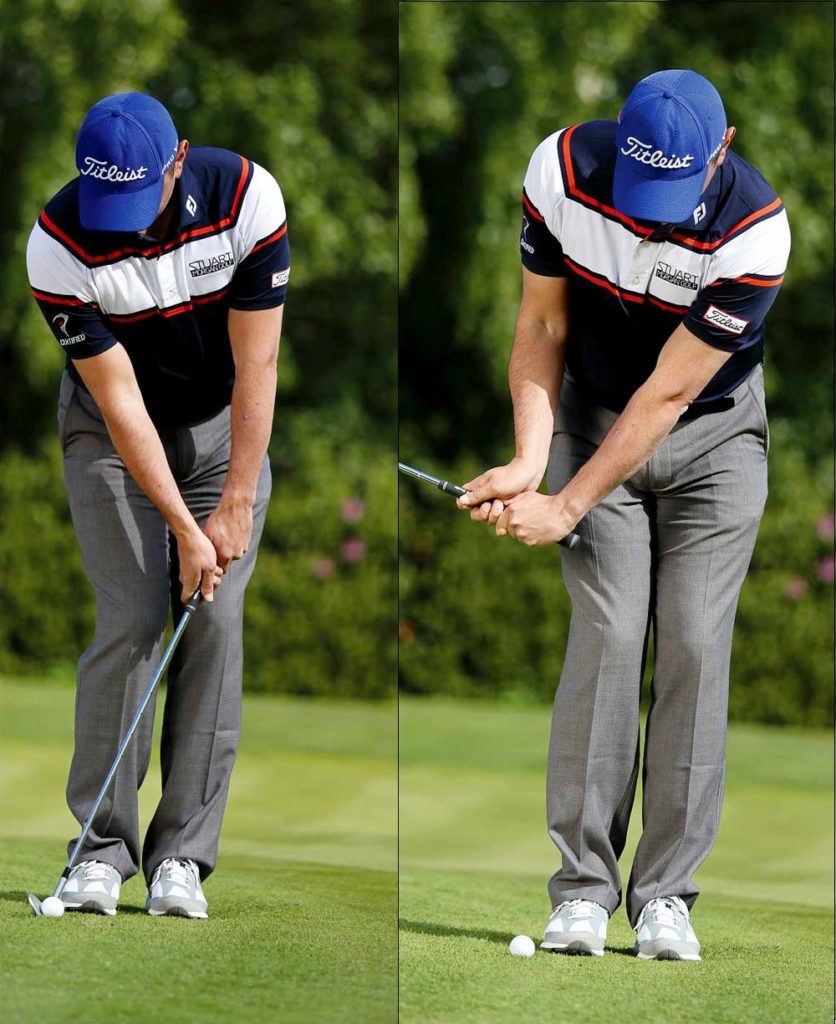

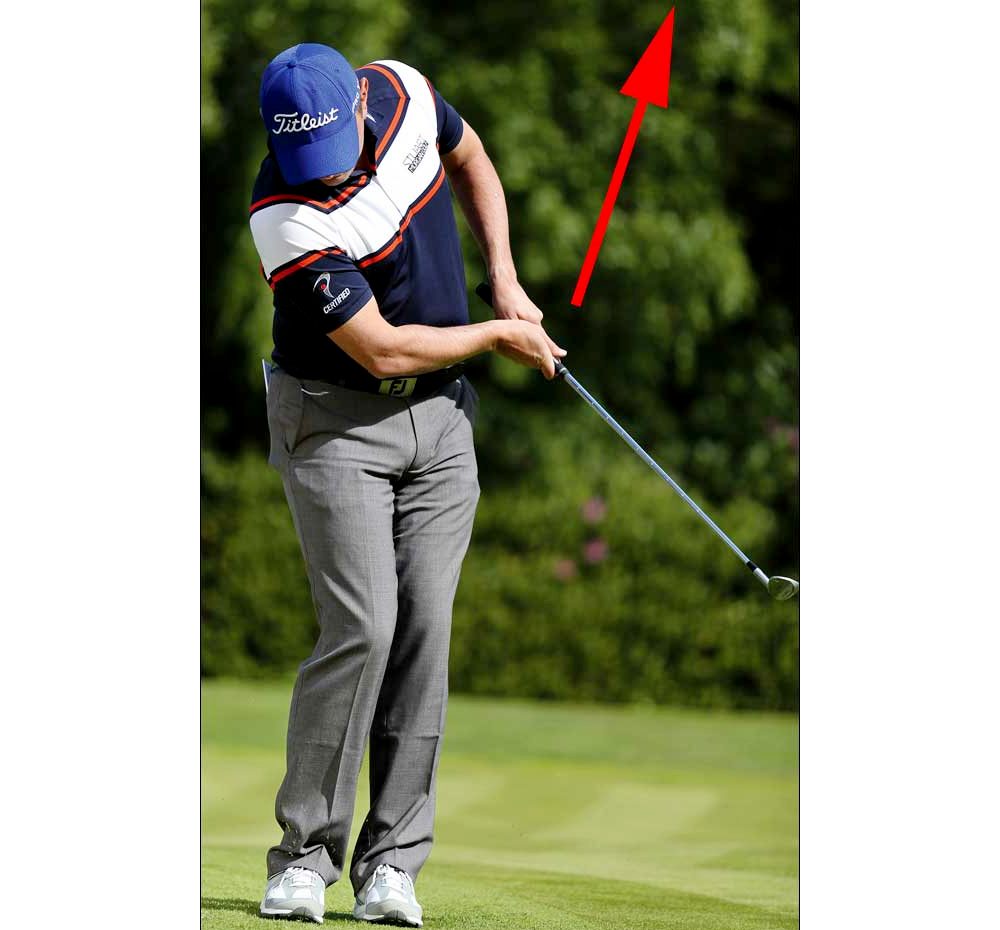
The faults we observe in the swing itself – the motion error – are a direct result of the extremes in the set up. The ‘ball back, weight forward, hands forward’ combination conspires to over-involve the wrists and the backswing is typically too long, and always too steep.
In the downswing (again, directly related to the set up and the length of the backswing) the forward motion is too short – the two halves of the swing are mis-matched, and there is no positive acceleration through the ball (vital to the quality of the strike). The angle of attack is too steep, and with an aggressive leading edge a high percentage of shots are going to be struck poorly. And as a player loses confidence, the cycle spirals out of control. How often do you see a golfer try to lift the ball into the air with the hands and the arms, winding up with a follow through like the one you see above? Rhythm is lost, and the increasingly jerky and nervy action can only be described as a physical ‘chip-yip’.
Over the page, let me explain how to neutralise your set-up position and make a more coordinated action. Along with a couple of easy drills, this will soon have you executing these critical scoring shots like a tour player.
Set-up fix: Move towards a more neutral starting position
Take your wedge and follow these simple keys to establish a better, more neutral set up position – one that enables you to utilise the true loft and bounce characteristics of the club.
• Play the ball just forward of middle
• Have the handle and shaft slightly forward towards the target
• Have 55% to 60% of your weight still favouring your left side (speaking for a right-handed golfer
• Create the posture that allows you to have your sternum over or just fractionally ahead of the ball
As you can see here, the club, the hands, arms and body are now all in alignment – and as a result of this harmony you create the conditions about which the stroke can flow from the set-up position; in short space of time you will feel much more in tune with the club you are holding and your control of its motion will come from your body centre, the arms and torso working together.
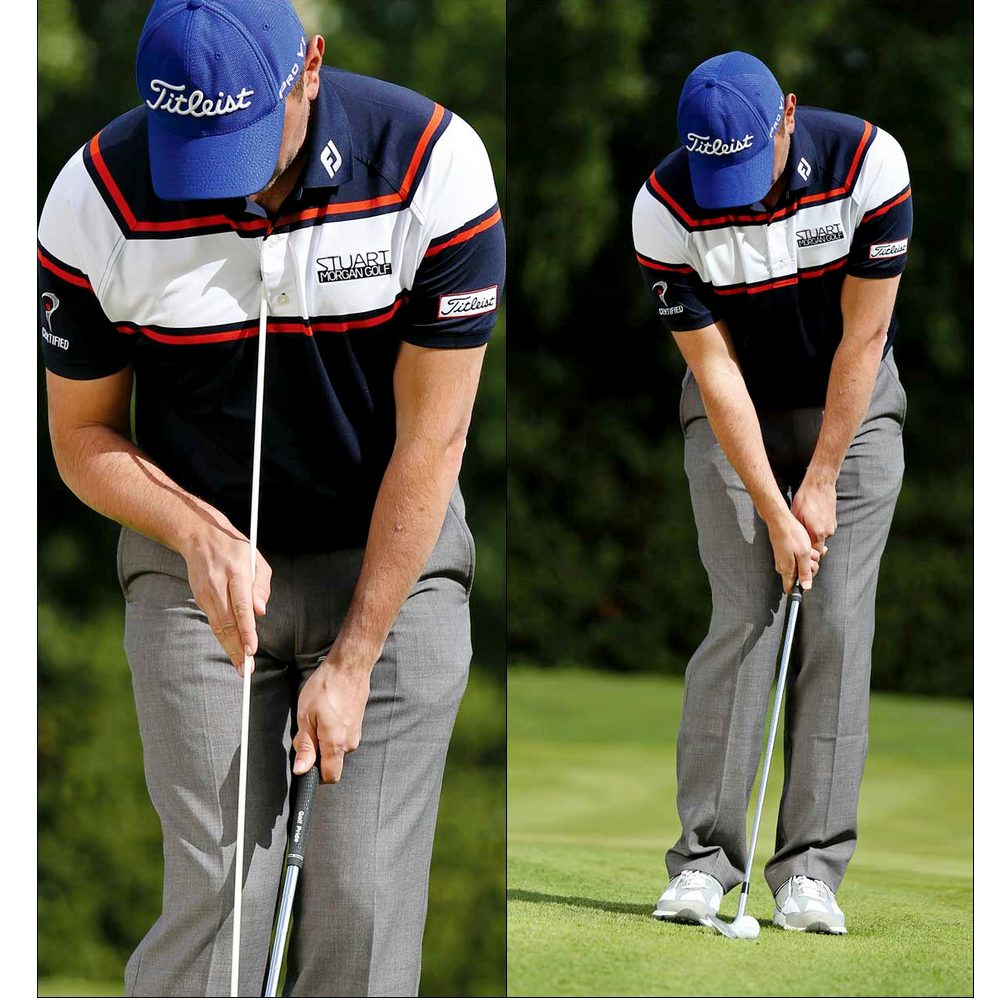
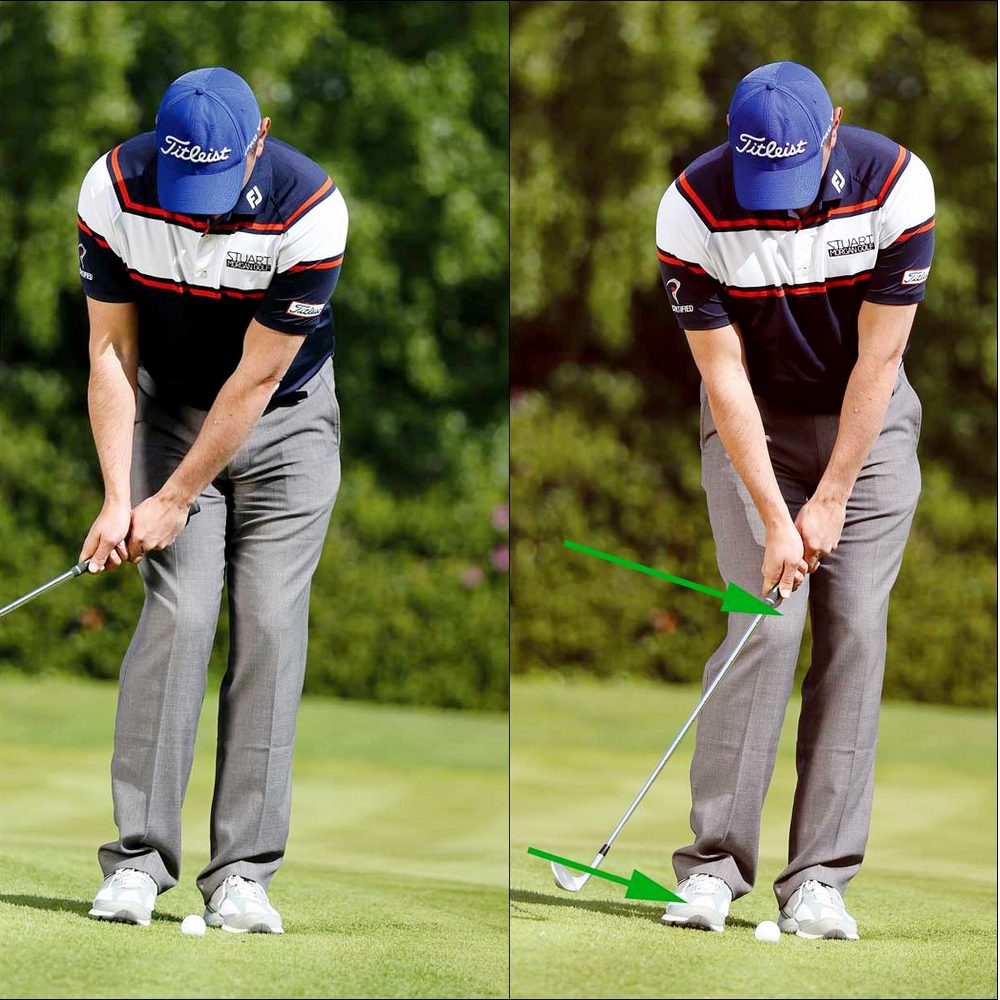
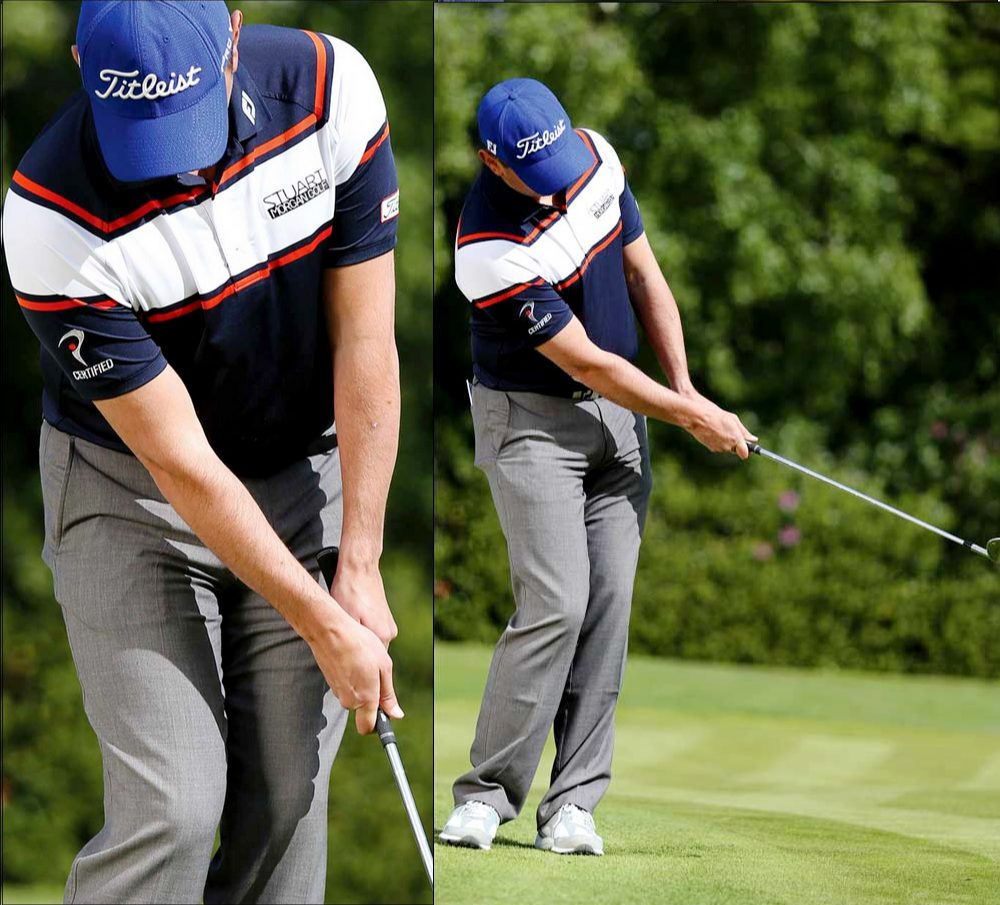
We are still looking for a slightly descending blow into the ball, but, taking excessive wrist action out of the equation the angle of delivery is now much more playable.
This is all about improving your consistency of strike. Shallowing out the swing path enables you to utilise the true loft on the clubface and you will also experience the benefit of ‘bounce’, with a lovely sensation of being able to ‘bruise’ the turf as you collect the ball. Go out and give it a try. I think you will be amazed at how much more tolerance you have in terms of the consistency of strike. This neutral technique simply gives you a margin for swing error that simply didn’t exist before. Enjoy it.
Keys to a neutral, more consistent chipping action
- In summary:
At set up, use an alignment cane to check the position of the sternum – remember, you need to retain this position all the way through the swing
Focus on the harmony of the motion between your hands, arms and the club, both back and then through the ball
As a practice exercise, focus on returning the clubshaft to its original set-up position. The better you do this, the more you be releasing the length of the shaft into the ball, not just the clubface (which will also eliminate any tendency to ‘hold-off’ the shot)
Thoughts & fixes: Try these easy drills to enhance technique and improve feel
Adjusting your technique along the lines I have suggested will help you to control the clubhead much more easily and consistently – ‘quietening’ the wrists in the execution of the swing, there is no longer the radical change in the inclination of the shaft during the stroke. That’s key, and one way to reinforce this quality in your technique is to practice your chipping with an alignment cane positioned just in front of you, angled to reflect the position of the shaft at address – i.e. relatively neutral, just leaning gently towards the target. The idea is then that you try and match up the shaft of the club you are swinging with that cane as you repeating your motion and collect the ball through impact. The better you get at doing this, the better the strike, the better your feel, and the greater the control.

The right hand works under the shaft, the face and bounce neutral

Avoid the extremes! Return the shaft to its set up angle – don’t drive it forward to the target
The right-hand only drill will help you to appreciate the sensation of releasing the whole shaft (as opposed to just the clubhead) to maintain the loft and the bounce characteristics of whatever club you are using. You can see here that the right hand (speaking for the right-handed golfer) stays under the shaft and the face stays looking up (again, similar to the set up). When a player gets too active with the clubface on the downswing, the leading edge of the club starts to rotate towards the ground (inset), which results in zero bounce. So as you rehearse this drill, feel your right hand stay under the shaft, the face neutral and the butt of the grip points towards the mid line of your body (as it did at the set up). This is an excellent feel for how the bounce works and what you can get away with, using the correct right side motion.
